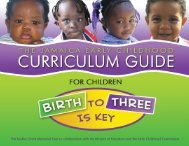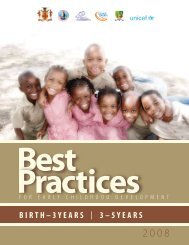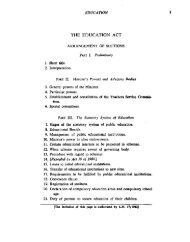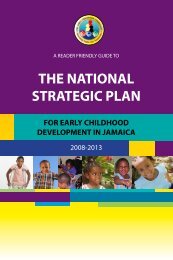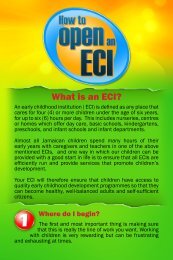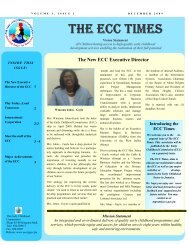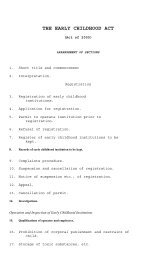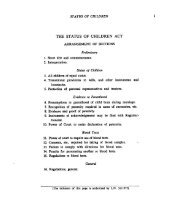The Jamaica Early Childhood Curriculum for Children Birth to Five
The Jamaica Early Childhood Curriculum for Children Birth to Five
The Jamaica Early Childhood Curriculum for Children Birth to Five
Create successful ePaper yourself
Turn your PDF publications into a flip-book with our unique Google optimized e-Paper software.
Toddlers are provided the opportunity <strong>to</strong> choose their activities<br />
A developmentally appropriate programme supports individuality and makes plans <strong>to</strong> ensure that children<br />
are not always subject <strong>to</strong> the considerations of the large group. This is particularly important in day care<br />
settings. <strong>The</strong>re<strong>for</strong>e group size and adult-<strong>to</strong>-child ratio should be maintained at a level that allows the adult<br />
<strong>to</strong> give the individualized attention that each child requires on a daily basis.<br />
<strong>The</strong> learning environment provides a range of activities appropriate <strong>to</strong> the developmental levels<br />
of individual children, so that their needs can be addressed. <strong>The</strong> child should be made <strong>to</strong> feel accepted<br />
<strong>for</strong> who he or she is and should never be compared <strong>to</strong> others or pressured <strong>to</strong> achieve beyond his or her<br />
natural ability. Some practitioners work in challenging circumstances with more children in a group than<br />
is desirable. However, in such circumstances, making each child feel that he or she is a special individual<br />
is not an impossible task. Getting <strong>to</strong> know each child well allows the practitioner <strong>to</strong> devote time relative<br />
<strong>to</strong> a child’s particular need. Some children are happy with a simple acknowledging <strong>to</strong>uch or smile from<br />
the adult, whereas others need further reassuring hugs and conversation. Recognizing and responding <strong>to</strong><br />
children’s individual needs is particularly important <strong>for</strong> young infants, <strong>to</strong>ddlers and children with special<br />
developmental and learning needs. Also, practitioners must be mindful of the gender differences in how<br />
children learn, their interests and per<strong>for</strong>mance levels. <strong>The</strong>y must be sensitive <strong>to</strong> the difference in the<br />
learning needs and styles of boys (who generally tend <strong>to</strong> have lower achievement rates than girls) and try<br />
<strong>to</strong> keep them focused and motivated <strong>to</strong> learn. However, girls and boys alike must be encouraged <strong>to</strong> pursue<br />
their individual interests and engage in learning activities without the limitations imposed by gender<br />
stereotyping.<br />
10



